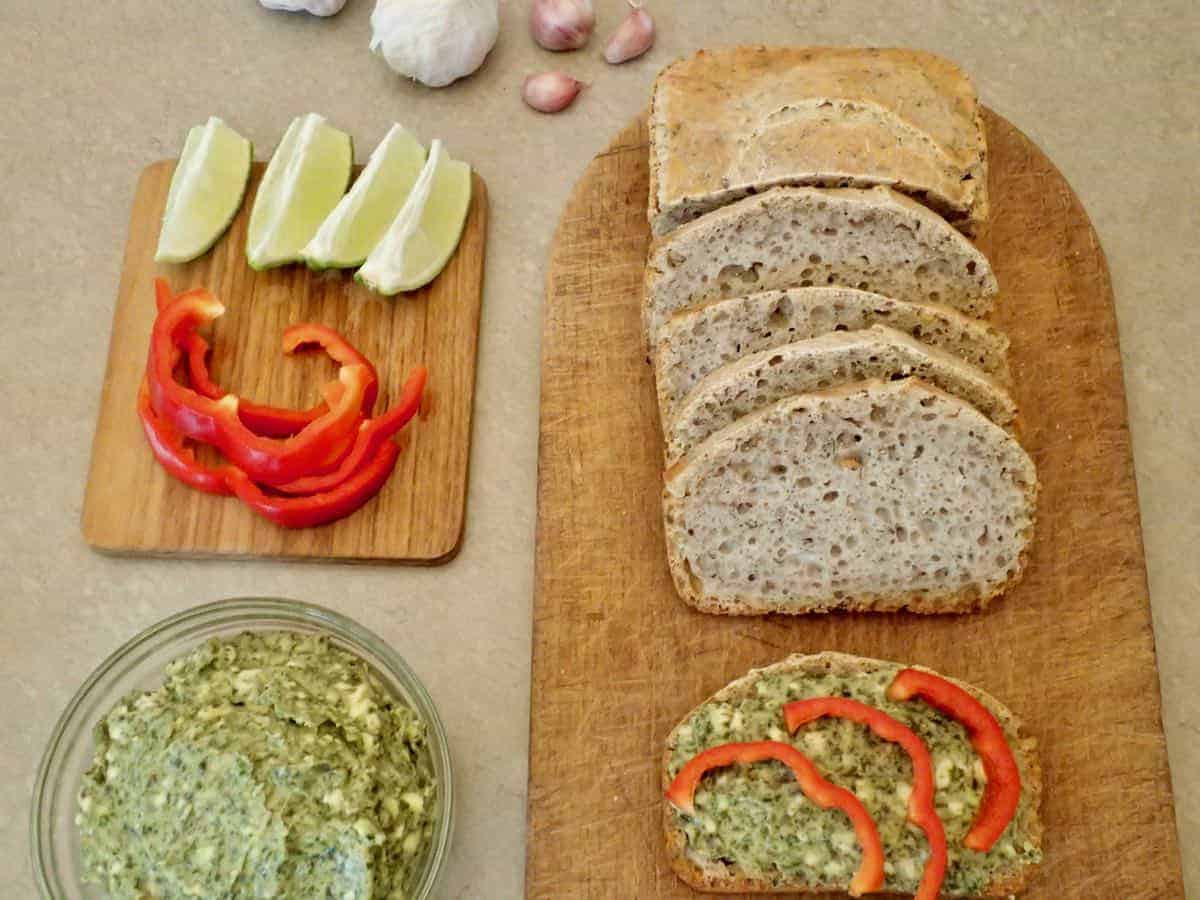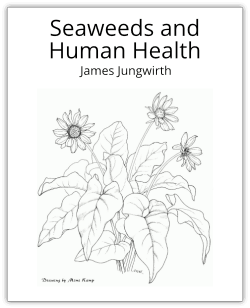Seaweeds and Human Health

By James Jungwirth
About the Author
James Jungwirth is an herbalist and wild crafter. He co-founded Naturespirit Herbs in 1990.
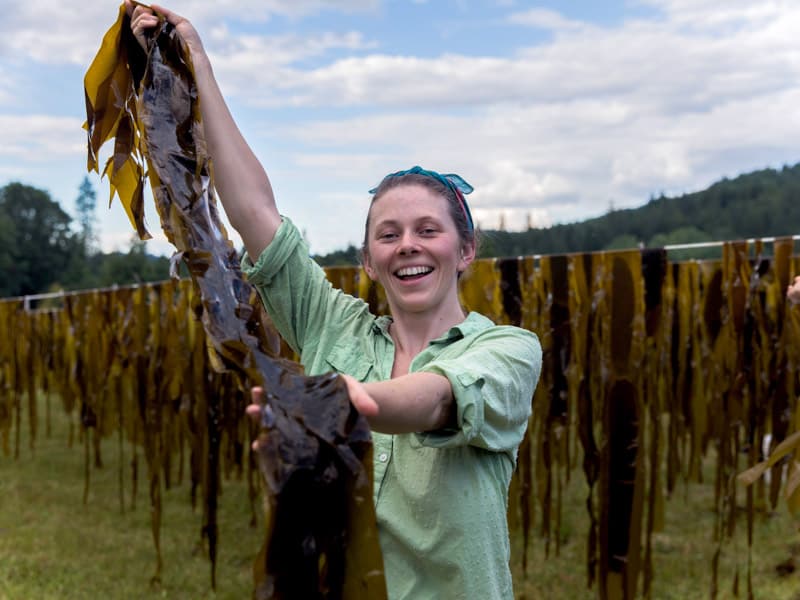
Seaweeds are plant-like ocean organisms that are botanically classified as macrophytic marine algae. Marine algae have been divided into three main groups, based more on their pigments and coloration than their genetics: red marine algae (Rhodophyta), brown marine algae (Phaeophyta) and green marine algae (Chlorophyta). “Kelp” is a somewhat vague term that loosely refers to the larger brown seaweed species. Edible seaweeds are often called “sea vegetables.”
In botanical terminology, seaweeds have holdfasts, stipes and blades (or fronds) instead of roots, stems and leaves. Their holdfasts function simply as anchors, and do not extract nutrients as do the roots of higher plants. Seaweeds absorb and concentrate nutrients directly from seawater. They do not make flowers or seeds, but reproduce by a mind-boggling (and perhaps even immoral) variety of complex reproductive schemes, most of which involve sperm, ova, and free-swimming “spores.”
Seaweeds come in an amazing variety of beautiful shapes, colors and sizes, and are found in all of the world’s oceans. They are most abundant in shallow rocky coastal areas, especially where they are exposed at low tide.
Coastal people around the world have been harvesting and eating sea vegetables since the beginning of time. In the United States and Europe, increasing numbers of people are learning that eating sea vegetables can provide a broad range of health benefits. Seaweeds are usually preserved by drying. This is the easiest and best way of preserving their flavor, nutrition and bioactivity. Most dried sea vegetables maintain their quality very well for a year or two if kept away from moisture, light and heat (like crackers, their flavor slowly fades, but nutrition and bioactivity are not affected). They keep very well in airtight glass jars in a dark cupboard.
Sea vegetables are some of the most nutritionally and therapeutically valuable foods on earth. Their value to human health is largely due to their high mineral content and to the therapeutic sulfated polysaccharides they contain. Seaweeds are also an abundant source of all the known vitamins, chlorophylls, lignans, polyphenols and antioxidants.
Many chronic diseases will improve or resolve simply by adding seaweeds to the diet. Eating sea vegetables regularly can facilitate the excretion of heavy metals, radioactive elements, dioxins and PCBs from our bodies, promote a healthy immune system, prevent thyroid disease, obesity, cancers and metastases, cardiovascular disease, type 2 diabetes, nervous system disorders, osteoporosis, reduce chronic inflammation, inhibit viruses (including herpes and human papilloma virus), and help regulate menses. In fact, the Japanese people’s remarkable longevity and extremely low incidence of cardiovascular disease, thyroid disease, breast cancer and prostate cancer may largely be due to the fact that they have the world’s highest per capita seaweed consumption!
Although many people eat sea vegetables as “health foods,” others consider them to be delicious gourmet foods, and eat them purely for gastronomic pleasure. They come in a wide variety of tastes and textures. Some sea vegetables may be eaten dried as salty snacks, like potato chips or jerky. Others are re-hydrated, cooked until tender, and eaten alone or in myriad recipes. Powdered seaweeds may be added to smoothies or sprinkled on foods as a salty condiment. Some people prefer the convenience of taking them in capsule form. There are several very good sea vegetable recipe books; these are listed in the bibliography.
How much seaweed is good to eat?
Three to six grams per day or 1 to 1.5 ounces of dried seaweed per week is a good average dietary amount for nutritional or therapeutic purposes. (That’s about 3 to 5 pounds per person per year.) Dr. Ryan Drum recommends eating both brown and red seaweeds in a 2 to 1 ratio for general health purposes. Small amounts taken with each meal every day would provide maximum benefit. Chew your seaweeds well. Powdered seaweeds are often easier to digest than whole seaweeds. If you experience gas or loose stools when you first start eating seaweed, try eating less and slowly increase the amount after a few weeks. The body and the digestive flora may take up to 3 months to learn to efficiently digest seaweeds.
Phycophobia
Many American and European people have varying degrees of cultural phycophobia (fear of seaweed) although this is slowly changing. Others do not want to eat seaweeds simply because they are reminded of the rotting piles of seaweed they have seen washed up on the beach; this is like not wanting to eat vegetables because you have seen a compost pile!
What about arsenic? In April of 2007, Amster et al. published an inflammatory article about arsenic in kelp (Case Report: Potential Arsenic Toxicosis Secondary to Herbal Kelp Supplement. Eric Amster, Asheesh Tiwary, and Marc B. Schenker Environ Health Perspect. 2007 April; 115(4): 606–608.). Although the article largely consists of an obvious jump to a preconceived conclusion, it has been widely bandied about in the medical community as “proof” that kelp and other seaweeds are unsafe for human consumption. This is simply not true. (Do you remember when Echinacea caused autoimmune disease?)
Seaweeds naturally contain an average of about 30 parts per million (ppm) by dry weight of arsenic. The USDA has no standards for allowable levels of arsenic in seaweeds. However, the European Pharmacopoeia (European Pharmacopoeia Commission 2007) allows up to 90 ppm of arsenic in kelp for use in medicinal products. Also, almost all of the arsenic in seaweeds occurs in the form of organically bound compounds (arsenosugars) which are relatively nontoxic.
Most seafood also contains moderate amounts of arsenic, and although they are usually consumed in much larger amounts than seaweeds, this is apparently not considered to be a health risk. If the arsenic in seaweed really was a health risk, the Japanese people, who have the world’s highest per capita consumption of seaweed, would all have chronic arsenic poisoning. They do not. As mentioned earlier, the Japanese people are some of the healthiest and longest-lived people in the world.
Seaweeds and water pollution
Seaweeds are at the bottom of the food chain and are therefore not prone to bioaccumulation of pollutants. However, seaweeds can absorb considerable amounts of heavy metals or radioactive elements if they are growing near a local point source of these pollutants, such as a nuclear power plant, mine, smelter, chemical plant, paper mill, landfill, waste dump, chemical agricultural region, etc. Heavy metals or radioactive elements can also be carried from these sources to the sea by rivers and streams.
Buying sea vegetables
Be cautious when buying imported sea vegetables. There is usually no way of knowing where or how these seaweeds were grown. Most of the seaweeds from Japan and other Asian countries are grown on aquaculture farms. Some are fertilized with chemical fertilizers; many are grown in polluted waters.
Most commercial kelp meals and powders come from eastern Canada, Norway or Iceland. These are often very inexpensive, but seem to be of universally poor quality in terms of smell and taste.
Harvesting your own seaweeds (see bibliography for more info)
Harvest from cleanest waters you can find. Ask local people, environmental groups and government agencies (such as the EPA) about local pollution sources before harvesting. Most states allow the personal harvest of 10 pounds or so of fresh seaweed per day without a permit.
Go to your harvest area at low tide, and carefully cut seaweed from the rocks, leaving the holdfasts and the base of the blades or fronds for regrowth. Harvest no more than 25% of the plants in a stand. Rinse any snails or sand off in the sea as you harvest. Fresh seaweed is as perishable as fresh fish; keep it cool and moist until you are ready to start drying it.
Dry seaweeds outdoors in full sun or in a warm, dry, well-ventilated room. Dry them as quickly as possible and do not allow them to re-dampen once they begin to dry. Hang larger seaweeds on ropes using clothespins; spread smaller seaweeds on nylon screens. If necessary, finish the drying in a heated room. Seaweeds are not fully dry until they snap crisply when bent. Store dried seaweeds in a cool dark place in airtight jars or buckets (or double bag them in heavy-duty food grade polyethylene bags).
Minerals
Seaweeds are by far the most concentrated natural food source of minerals, electrolytes and trace elements (20 to 50% of dry weight) in a ratio that is remarkably similar to that of our own blood. This similarity may not a coincidence, since marine algae were presumably the first foods available to the first animal life on this planet.
Ever since the time our distant ancestors left the ocean and began to live on land, our bodies have had to work much harder to find, ingest, absorb and selectively retain or excrete minerals in order to maintain the “internal ocean” (blood plasma and interstitial fluid) that bathes and feeds our cells.
The ratio and concentration of minerals in our blood plasma and interstitial fluid is so vitally important that our bodies will steal minerals from our bones and other tissues to maintain it. Ongoing mineral deprivation of bone and other tissues can result in chronic disease (Paul Bergner does a wonderful job of documenting the connection between dietary mineral deficiencies and chronic disease in his book, “The Healing Power of Minerals”).
Eating seaweeds regularly may be the best way to be sure that we are ingesting enough of all the minerals we need for optimum health. This is especially important today because modern chemical farming, depleted soils and processed foods have resulted in widespread mineral deficiency-caused disease.
Essential minerals and trace elements found in seaweeds include boron, calcium, chloride, chromium, cobalt, copper, fluoride, iodine, iron, lithium, magnesium, manganese, molybdenum, potassium, phosphorus, selenium, silicon, sodium, sulfur and zinc. The amounts of each mineral vary widely between species, season of harvest and area of harvest.
The electrolytes potassium and sodium
Potassium and sodium are the two most important electrolyte minerals. Adequate potassium and sodium are necessary for the proper functioning of our nervous system, muscles, heart, kidneys and pancreas, and for regulating blood pressure and blood sugar.
Most people are aware that too much sodium in the diet can cause hypertension (high blood pressure). However, the level of sodium in one’s body is actually less of an issue than the sodium-to-potassium ratio. An excessive sodium-to-potassium ratio in the body causes it to retain water and increase blood volume, causing hypertension.
Most western diets provide too much sodium and not enough potassium. Excessive sodium intake washes potassium out of the body through the urine. Potassium deficiency can also be brought on by medications such as diuretics and cortisone.
Increasing dietary potassium can also help the body adapt to stress (our bodies respond to stress by retaining sodium and excreting potassium through the urine).
Seaweeds are some of nature’s most concentrated sources of potassium and sodium, in a nearly ideal ratio. Their salty taste is mostly due to their high potassium content; potassium is much saltier to the taste than sodium. Dr. Ryan Drum has observed that a craving for salt is usually a misplaced craving for potassium, since the human tongue cannot distinguish between the two, and sodium deficiency is extremely rare. So if you crave salt, eat some seaweed!
Blood sugar regulation
Eating seaweed can help people regulate their blood sugar better. Potassium, chromium, magnesium and other minerals are essential to blood sugar regulation. Also, the polysaccharides in seaweeds slow the absorption of dietary sugars and help prevent blood sugar and insulin spikes.
Type 2 (adult onset) diabetes is largely the result of a diet that is high in empty calories (refined sugars, fats and starch) and low in the vitamins and minerals needed to burn them (eat your vegetables!). Their bodies have had no choice but to store these empty calories; eventually, all of their cells become so full they can’t fit any more in response to insulin, hence the name “insulin resistant diabetes.” Type 2 diabetes has also been linked with low thyroid function, chronic stress, high cholesterol, obesity etc.
Seaweeds also often benefit people with hypoglycemia (low or unstable blood sugar, often associated with high carbohydrate, low fat and low protein diets). If you give seaweed (especially Kelp Fronds) to kids that have had too much sugar or who are crashing from low blood sugar, it’s amazing how fast it grounds their energy!
Nervous system disorders and muscle spasms
Most seaweeds have a distinct calming effect on the nervous system and muscles, and eating them regularly can often help or even resolve ADHD, nervousness, irritability, anxiety, depression, insomnia, fibromyalgia, muscle spasms, tics and restless legs syndrome. The high levels of potassium, sodium, calcium, magnesium, and other minerals in seaweeds are food for the nervous system and muscles, and are largely responsible for this calming effect. Many brown seaweeds also contain surprisingly high levels of melatonin, which may also play a part. Nervous system and muscle disorders are also often closely linked to blood sugar regulation and thyroid function.
Iodine
The thyroid gland needs iodine to produce thyroid hormones, which regulate our metabolism, circulation, energy level, sense of well-being, immune system, and growth of skin, hair and fingernails. Iodine is also essential to healthy breast, ovary, testes, prostate and salivary gland health and function.
Most Americans do not get enough dietary iodine. Chlorinated water, fluoridated water and toothpaste, aspirin and many prescription drugs increase the need for dietary iodine. Land plants are not a reliable source of iodine; most seaweeds contain hundreds of times as much as any land plant. The brown seaweeds, especially Kombu (Laminaria spp.) are especially high in iodine. Consumption of 3 to 6 grams of most dried seaweeds daily will provide adequate dietary iodine. Excess iodine is easily excreted through the urine.
Seaweeds and thyroid function
Bladderwrack (Fucus spp.) Kombu (Laminaria spp.) and Sargasso Weed (Sargassum spp.), which are all brown seaweeds, have a long history of use in different parts of the world to prevent and treat underactive thyroid (hypothyroid) conditions, obesity and goiter. This is because of their very high iodine content and because much of this iodine occurs in the form of thyroid hormone precursors (MIT and DIT) that are particularly easy for the thyroid gland to assemble into thyroid hormones.
In addition, actual thyroid hormones (T3 and T4) have been found in significant amounts in Kombu and Sargasso Weed (other brown seaweeds may contain T3 and T4 as well). These seaweeds could, therefore, be expected to provide actual thyroid activity in the body in addition to supplying iodine to the thyroid.
Why would seaweeds bother to produce animal thyroid hormones? That is a good question, but it may also be the wrong question, because marine algae probably made T3 and T4 long before animal life existed! Marine algae were among the first foods available in the history of life on earth. It is reasonable to assume that early animal life became physiologically dependent on the constant presence of algal T3 and T4 in their diet and later learned to make their own.
Hypothyroid (underactive thyroid) conditions are rampant and continually increasing in the USA. Symptoms include intolerance to cold, fatigue, depression, forgetfulness, slow metabolism, high cholesterol, weight gain, water retention, constipation, dry skin and hair, brittle nails, immune deficiency, muscle cramps and heavy menses. (Chronic fatigue syndrome, fibromyalgia and type 2 diabetes are also often associated with low thyroid function.) Hypothyroidism occurs much more often in women than men.
Causes of hypothyroidism include exposure to radioactive iodine (I-131), heavy metals, dioxins, PCBs, PBDEs (flame retardants), resorcinol-based glues or MTBE gasoline additives; autoimmune thyroid disease (Hashimoto’s thyroiditis etc.), long term adrenal exhaustion, long term veganism, excessive consumption of soy products and insufficient dietary intake of iodine, selenium or L-tyrosine. Underactive thyroid conditions can also be a non-pathological response to grief, depression, or menopause.
Many people are successfully using seaweeds to treat their hypothyroid conditions and avoiding the use of synthetic thyroid hormones (and the associated health risks). Some people are even able to slowly wean themselves from synthetic thyroid hormones with concurrent long-term use of seaweeds. Thyroid nodules also often resolve with long term use of brown seaweeds.
In my own experience, 3 to 6 grams daily of powdered Kombu (Laminaria setchellii) or Bladderwrack (Fucus gardneri) is a highly effective treatment for hypothyroid patients. Kombu seems to be somewhat more effective than Bladderwrack. Gotu Kola (Centella asiatica), Ashwagandha (Withania somnifera), Eleuthero (Eleutherococcus senticosus) and various species of Reishi (Ganoderma lucidum, G. oregonense and G. tsugae) or Artist’s Conk (Ganoderma applanatum) can also be very helpful for people with hypothyroidism.
People seeking more detailed holistic information on thyroid function and disease should read Dr. Ryan Drum’s brilliant thyroid articles (see bibliography).
Iodine sensitivity and hyperthyroidism
Some people are extremely sensitive to the iodine in seaweed and may show signs and symptoms of hyperthyroidism (excessive thyroid function): nervousness, insomnia, rapid heartbeat, heart palpitations, excessive sweating etc. These people should be cautious about the amount of seaweed in their diet. People with chronic hyperthyroidism probably should not eat seaweed (especially Kombu or Bladderwrack).
Osteoporosis
The high levels of minerals in sea vegetables make them some of the world’s most alkalizing foods. Maintaining an alkaline body is essential to good health in general, and to preventing osteoporosis in particular. If our blood becomes too acidic, our bodies will take calcium from our bones to buffer our blood’s pH. Over time, this can lead to decreased bone density, or osteoporosis. Eating sea vegetables regularly can reduce our need for calcium/magnesium supplements and help prevent osteoporosis.
Vitamins: Seaweeds are an excellent source of all the known vitamins, particularly the B vitamins. Vitamin content varies widely between species, season of harvest and area of harvest.
Therapeutic sulfated polysaccharides
Seaweeds contain large amounts (25 to 40% of dry weight) of therapeutic sulfated polysaccharides, including algin, fucoidan and laminarin, which are produced by brown seaweeds, and carrageenans, agar, and porphyran, which are produced various red seaweed species. These unique seaweed gels are the means by which seaweeds absorb and concentrate minerals from seawater. They also have many amazing beneficial health effects.
Water-soluble fiber
All seaweed gels are relatively indigestible by humans and act as high-quality water-soluble fiber in our digestive tracts and as food for our colon flora. This may be why many seaweeds are considered to be soothing intestinal tonics in many Asian medical traditions.
Protection from heavy metals and radioactive elements
Algin, a polysaccharide found in all brown seaweed species, will bind with heavy metals and many radioactive elements in the food, water and digestive juices in our gastrointestinal tract. This prevents their absorption or reabsorption and allows them to be eliminated through the feces. Fucoidan, laminarin, carrageenans and agar all have similar properties. This means that eating seaweeds (especially the brown seaweeds) regularly can effectively reduce our body loads of these toxic elements. The potential value of this to human health cannot be underestimated.
The average American today has hundreds of times more lead in his or her body than a century ago, primarily because of the use of tetraethyl lead in gasoline for 65 years (it was outlawed in the USA in 1989) and from commercial lead smelters, incinerators, etc. Most Americans also have some degree of mercury toxicity from amalgam dental fillings, coal-burning power plants, cement production and contaminated ocean fish. Both heavy metals can cause serious neurological disorders, autoimmune diseases, hypothyroidism, cancers and birth defects.
In 1957 the U.S. Atomic Energy Commission recommended taking five grams of powdered kelp, algin or sodium alginate daily for protection from the radioactive fallout from atmospheric nuclear testing. This is probably good health advice for today as well. Scientific studies measuring Strontium-90 (Sr-90) in the deciduous teeth of children and the bones of adults indicated that although levels declined during the 1970s, they were as high in the 1980s and 1990s as they were during the late 1950s, when radioactive fallout from above-ground nuclear testing was at its peak. Sr-90 is easily traced in the body because it is deposited in the bones and teeth and has a relatively long half-life (29.78 years). It continuously emits radiation as it decays, causing bone cancers and leukemias.
It is a deplorably under-publicized fact that all nuclear power plants regularly release radioactive Iodine (I-131) into the atmosphere. The I-131 attaches to water droplets and dust particles and descends to the earth’s surface, entering food (especially milk) and water supplies. When ingested, I-131 concentrates in the tissues that need the most iodine; the thyroid gland, ovaries or testes, salivary glands and, in women, the areola of the breast as well. As the I-131 decays (it has a half-life of 8 days), it irradiates and damages these tissues, causing loss of function, autoimmune diseases and cancers. Most cancers do not show up until at least 15 years after exposure. People that live near nuclear power plants have significantly higher rates of autoimmune diseases, cancers and birth defects.
When meltdowns occur at nuclear power plants (such as Chernobyl or Three Mile Island) large amounts of I-131 and other radioactive elements are released into the atmosphere. According to the National Institute of Health, the I-131 fallout from the nuclear accident at Chernobyl caused large numbers of people worldwide (including the United States) to contract thyroid cancer.
If a person maintains a full body load of natural iodine (I-127), the radioactive iodine is not absorbed. Seaweeds, especially the brown seaweed species, are by far the most concentrated natural food source of iodine.
Protection from dioxins and PCBs: Dioxins and PCBs are particularly insidious environmental pollutants because they are extremely toxic, extremely stable, and extremely lipophilic, and because they concentrate in animal fats as they move up the food chain. Humans get most of their dioxins and PCBs from meat and dairy products. Once ingested, dioxins and PCBs are very readily absorbed and very slowly excreted, so they tend to stay in the liver, brain and body fat for decades.
We are all carrying significant body loads of these toxins. Dioxins and PCBs are and can cause cancer, immune system damage, autoimmune disease, hormone disruption, thyroid disease, endometriosis, infertility, miscarriage, birth defects, learning disabilities, lowered testosterone levels, reduced sperm counts, diabetes, lung problems and skin disorders.
A landmark research study conducted by Morita and Nakano (Morita K, Nakano T: Seaweed accelerates the excretion of dioxin stored in rats. J Agric Food Chem 2002, 50:910-917) clearly demonstrates that regular consumption of Wakame, Kombu and Hiziki by rats reduces absorption of dioxins and PCBs from food (and reduces the reabsorption of dioxins and PCB from the digestive juices secreted into the gastrointestinal tract) allowing them to be eliminated through the feces, effectively reducing body loads of these toxic chemicals. (Wakame, Kombu and Hiziki are brown seaweeds; I assume that it is the polysaccharides in the brown seaweeds that are binding with the dioxins and PCBs.) Morita and Nakano’s research strongly suggests that eating brown seaweeds regularly can effectively reduce body loads of dioxins and PCBs for humans as well.
Fucoidans
Fucoidans are a class of sulfated polysaccharides found in most brown seaweed species (5 to 20% by dry weight). Fucoidans have received a lot of attention from the research community because they have demonstrated so many broadly beneficial health effects. They have strong immune enhancing, immune-modulating, anti-inflammatory, antioxidant, anticoagulant, cholesterol-lowering, anti-cancer, and anti-metastatic activity.
Immune enhancement and virus inhibition
Perhaps the most significant aspect of fucoidans is their ability to build up and strengthen the immune system. Fucoidans also possess strong inhibitory activity against a number of coated viruses, such as HSV-1, HSV-2, HPV, EBV, CMV and HIV. Their mechanism of action involves blocking virus entry into cells, rather than killing the virus directly.
Immune modulation
Fucoidans also provide an array of health benefits via their ability to modulate the immune system. Immune modulating substances have the ability to increase immune function when it is depressed, as in conditions like chronic fatigue syndrome, and to reduce it when it is over-stimulated, as in auto-immune diseases like lupus or rheumatoid arthritis, allergies, etc.
Healing from tissue trauma
Dr. Ryan Drum has noted that consumption of fucoidan-rich brown seaweed broths seems to prevent bruising, reduce inflammation and speed tissue healing after injuries or surgery. The researched antioxidant, anti-inflammatory and anticoagulant activity of fucoidans would strongly support his observation.
Cancers and metastases
Researchers have determined that fucoidan tends to combat cancer by reducing angiogenesis (blood vessel growth), inhibiting metastasis (spreading of cancer cells to other parts of the body), and promoting the death of cancer cells (apoptosis).
Seaweeds and cardiovascular health
Eating seaweeds regularly, especially the brown seaweeds, improves the quality of the blood, which is the key to cardiovascular health. Seaweed provides abundant minerals for the blood, blood vessels, heart and kidneys. It provides blood thinning, anti-inflammatory and antioxidant polysaccharides, which keeps the blood thin and easier for the heart to push through the blood vessels, prevents clots from forming, prevents free radical damage to the blood vessels and keeps plaques from clogging the blood vessels that feed the body.
The fucoidans in brown seaweeds improve lipid metabolism in the liver, which decreases the total amount of serum cholesterol and improves the ratio of good (HDL) cholesterol to bad (LDL) cholesterol. Seaweed also helps keep thyroid hormones at optimal levels, which is also supports healthy cholesterol levels and the prevention of atherosclerosis.
Blood pressure
The hypotensive effect of many brown seaweeds, especially Kombu (Laminaria spp.) and Bladderwrack (Fucus spp.) has been well established in folk medicine and with modern research.
Irregular or painful menses
Regular consumption of brown seaweeds often helps regulate the menstrual cycle. This may be due to the estrogen-lowering fucoidans and lignans or to simple thyroid stimulation.
Carrageenans
Carrageenans are immune-enhancing, broad-spectrum anti-viral (including HSV-1, HSV-2 and HPV) sulfated polysaccharides found in many red seaweed species. Some species contain more than others. The various Pacific species of the genus Gigartina (also known as Mastocarpus or Grapestone), as well as the Atlantic species Chondrus crispus (Irish Moss), are particularly high in carrageenans (50 to 80% of dry weight). Carrageenans are also widely used in the food industry as thickening and stabilizing agents and in cosmetic and skin care products.
There are a variety of products made from different red seaweed species being marketed today for topical and internal use for suppression of herpes simplex 1 and 2, mostly under the generic name of Red Marine Algae. I have no solid data on their efficacy in real life.
Organoleptic experiment with seaweed and HSV-1
I have been using 5 to 10 grams daily of a mix of six powdered brown and red seaweeds during the last two years. I would normally have expected to get five or six outbreaks of oral herpes (HSV-1) during this time. However, during the last two years I have had only one very mild outbreak, and that was after a period of slacking off in my use of these seaweeds for a few weeks.
REFERENCES AND BIBLIOGRAPHY
1. McConnaughey, Evelyn. Sea Vegetables Harvesting Guide & Cookbook. 1985. ISBN: 0-87961-151-0
2. Lewallen, John. Sea Vegetable Gourmet Cookbook and Wildcrafter’s Guide. 1996. ISBN: 0-9647643-7-7
3. Jungwirth, James. Preferred Harvest Methods for Common Oregon Seaweeds. www.naturespiritherbs.com
4. Bergner, Paul. The Healing Power of Minerals. 1997. ISBN: 0-7615-1021-4
5. Drum, Ryan. Medicinal Uses of Seaweeds. www.ryandrum.com
6. Drum, Ryan. Sea Vegetables as Food and Medicine. www.ryandrum.com.
7. Drum, Ryan. Environmental Origins of Thyroid Disease. www.ryandrum.com
8. Cooksley, Valerie. Seaweed. 2007. ISBN 13: 978-1-58479-538-4
9. Dreuehl, Louis. Pacific Seaweeds. 2000. ISBN: 1-55017-240-9
10. Erhart, Shep. Sea Vegetable Celebration. 2001. ISBN: 1-57067-123-0
Did you find this article helpful? Please consider sharing it with a friend!
Read These Next:
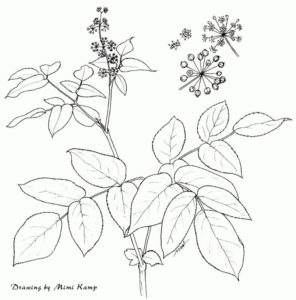
Environmental Origins of Thyroid Disease – Part 2
What hazards do nuclear radiation pose to your thyroid gland? And how did the Chinese solve their country-wide, iodine deficiency problem.
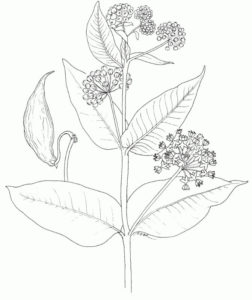
Seaweed 101
What are sea vegetables and what are they good for? Why would you consider adding seaweeds to your diet? Learn some seaweed facts that might surprise you.

[Listen] James Jungwirth on Herb Mentor Radio
Please enjoy this wide-ranging conversation between Naturespirit co-founder James Jungwirth and John Gallagher of Herb Mentor Radio and Learning Herbs.


